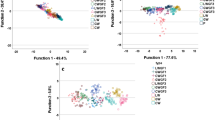Abstract
The optimal brewing conditions for Turkish green tea were determined on the basis of extracted catechins and sensory attributes. Green tea infusions were prepared at 75, 85 and 95 °C with brewing times of 1, 2, 3, 5, 10, 20, 30 and 45 min. The amounts of epistructured catechins (EGCG, EGC, ECG, EC), non-epistructured catechins (C, GC, GCG) and caffeine in brewed tea samples were analysed. Sensory analyses were performed by nine trained panelists for infusion colour, taste, aroma and overall acceptability. Brewing at 85 °C for 3 min was found to be the optimal condition, where the EGCG content was at a maximum of 50.69 mg/100 ml with the highest sensory scores. It was observed that the yield of epistructured catechins increased rapidly for the first 3–5 min of brewing at 85 °C, and increased brewing time resulted in a decrease in the yield of epistructured catechins. The amount of nonepistructured catechins continued to increase with longer extraction times. Sensory scores for infusion colour, taste, aroma and overall acceptability were highest at 3 and 5 min brewing times at all temperatures. Sensory scores were very low for 30 and 45 min brewing at 85 and 95 °C due to the bitter taste and dark colour.




Similar content being viewed by others
References
Ananingsih VK, Sharma A, Zhou W (2013) Green tea catechins during food processing and storage: a review on stability and detection. Food Res Int 50(2):469–479
Astill C, Birch M, Dacombe C, Humphrey PG, Martin PT (2001) Factors affecting the caffeine and polyphenol contents of black and green tea infusions. J Agric Food Chem 49:5340–5347
Chen CW, Ho CT (1995) Antioxidant properties of polyphenols extracted from green and black teas. J Food Lipids 2:35–46
Chu DC (1997) Green tea—its cultivation, processing of the tea leaves for drinking materials, and kinds of green tea. In: Juneja LR, Chu DC, Kim M (eds) Chemistry and applications of green tea. CRC Press, Boca Raton, pp 1–11
FAOSTAT (2013) Food supply statistics for tea. http://faostat3.fao.org. Accessed 31 May 2013
Fernandez PL, Pablos F, Martin MJ, Gonzales AG (2002) Study of catechin and xantine tea profiles as geographical tracers. J Agric Food Chem 50:1833–1839
Graham HN (1992) Green tea composition, consumption, and polyphenol chemistry. Prev Med 21(3):334–350
Gramza A, Korczak J (2005) Tea constituents (Camellia sinensis L.) as antioxidants in lipid systems. Trends Food Sci Technol 16:351–358
ISO 1572 (1980) Methods of test for tea–Part 1: Preparation of ground sample of known dry matter content
ISO 14502-2 (2005) Determination of substances characteristic of green and black tea—Part 2: Content of catechins in green tea—Method using high-performance liquid chromatography
Labbe D, Tremblay A, Bazinet L (2006) Effect of brewing temperature and duration on green tea catechin solubilisation: basis for production of EGC and EGCG enriched fractions. Sep Purif Technol 49:1–9
Perva-Uzunalic A, Skerget M, Knez Z, Weinreich B, Otto F, Grüner S (2006) Extraction of active ingredients from green tea (Camellia sinensis): extraction efficiency of major catechins and caffeine. Food Chem 96:597–605
Vuong QV, Golding JB, Stathopoulo CE, Nguyen MH, Roach PD (2011) Optimizing conditions for the extraction of catechins from green tea using hot water. J Sep Sci 34:3099–3106
Wang R, Zhou W, Jiang X (2008) Reaction kinetics of degradation and epimerization of epigallocatechin gallate (EGCG) in aqueous system over a wide temperature range. J Agric Food Chem 56:2694–2701
Wei K, Wang L, Zhou J, He W, Zeng J, Jiang Y, Cheng H (2011) Catechin contents in tea (Camellia sinensis L.) as affected by cultivar and environment and their relation to chlorophyll contents. Food Chem 125:44–48
Wu C, Xu H, Heritier J, Andlauer W (2012) Determination of catechins and flavonol glycosides in Chinese tea varieties. Food Chem 132:144–149
Zimmerman BF, Gleichenhagen M (2011) The effect of ascorbic acid, citric acid and low pH on the extraction of green tea: how to get most out of it. Food Chem 124:1543–1548
Acknowledgments
This research was supported by TUBITAK under the project entitled TARAL 1007 for CAYKUR. We wish to thank the CAYKUR Tea Factory for supplying the green tea used in this study.
Author information
Authors and Affiliations
Corresponding author
Rights and permissions
About this article
Cite this article
Saklar, S., Ertas, E., Ozdemir, I.S. et al. Effects of different brewing conditions on catechin content and sensory acceptance in Turkish green tea infusions. J Food Sci Technol 52, 6639–6646 (2015). https://doi.org/10.1007/s13197-015-1746-y
Revised:
Accepted:
Published:
Issue Date:
DOI: https://doi.org/10.1007/s13197-015-1746-y




